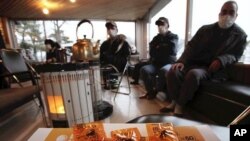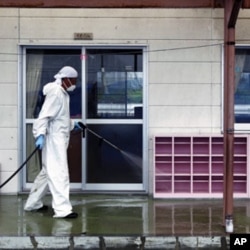Japanese doctors on Sunday began checking the thyroids of 360,000 children in Fukushima Prefecture, site of a nuclear reactor meltdown during the days following Japan's earthquake and tsunami in March. The examinations, on a scale medical officials are calling unprecedented, come amid concern that the cancer rate in the area could surge.
Ultrasonic thyroid examinations
Children from the two towns closest to the Fukushima-1 Nuclear Power Plant were among the first to undergo ultrasonic thyroid examinations at the Fukushima Medical University.
The power plant was severely damaged after this year's massive earthquake and tsunami which left 20,000 people dead or missing.
Dr. Shinichi Suzuki, of the university's medical school, says it will take several years to carry out preliminary examinations of those 18 and under in the prefecture (state).
The physician says it can take a long time for any irregularities in the thyroid to manifest as cancer. While that was seen four or five years after the 1986 Chernobyl meltdown in Ukraine, he says some experts contend a longer period of vigilance will be needed here.
Family's reaction
A father from the evacuated village of Itate says his child's initial checkup Sunday was encouraging.
The man says since the procedure is so simple it should be repeated on a regular basis.
A mother from Namie, another town evacuated, concurs.
She says she is anxious to quickly know the results of the examinations.
About 5,000 children who were living closest to the nuclear plant when the meltdowns occurred are being examined first. In all, 360,000 children will be checked.
Follow-up exams
Officials say follow-up exams will be conducted every two years until the children reach the age of 20. After that, checkups will be done every five years. If any lesions are discovered then more detailed exams will be conducted.
More than six months after the Tokyo Electric Power Company facility was crippled, emergency crews are still trying to halt radiation emissions.
Tens of thousands of people have not been allowed to return to their homes in a 20-kilometer radius from the plant. The accident has also contaminated livestock, fish and crops. But no human deaths have been attributed to radiation from the meltdowns.
IAEA visit
The area received a visit on Sunday from a 12-person team dispatched by the International Atomic Energy Agency.
The U.N. agency is providing assistance to Japan, at Tokyo's request, to cope with the world's worst nuclear accident since Chernobyl.
The mission's leader, Juan Carlos Lentijo of Spain, on site in Fukushima told reporters it will take some time to review Japan's efforts to mitigate the disaster.
"We are visiting very interesting places," said Lentijo. "We have to analyze all the information they are providing to us, which is a lot."
The IAEA says it is also discussing decontamination efforts with local authorities in Fukushima. The cleanup is expected to last for years and cost billions of dollars.










